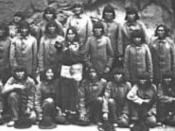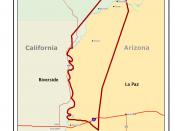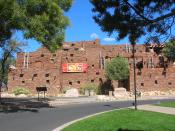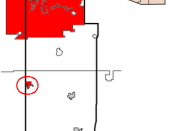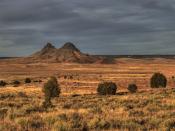The Hopi people of Arizona are one of the Southwestern Pueblo native tribes from the northeast. Archaeologists believe the Hopi people emerged into the southwest originally from the area now South America, Central America, and Mexico. They believe the Hopi people migrated to Arizona by way of movement along the Colorado Plateau. They are farmers and thought to have migrated by abandoning villages once the land could no longer be cultivated, or possibly destroyed by natural disasters. The Hopi are tied to the archaeological sites in and around the Grand Canyon and the Colorado Plateau which they consider sacred ground (Coder 2000). The current reservation is in the northeastern part of Arizona called Black Mesa. They are surrounded by the Navajo reservation. Most of the Hopi people live in this reservation however there are some that live on the Colorado River Indian Reservation in western Arizona (Legends of America).
Oral stories and traditions are passed down from each Hopi clan as their way of perpetuating their culture through generations.
Some stories have differed between clans within the Hopi tribes however the main emergence story is told of how they were given the leftover small ears of corn after others pushed their way through for the large ears given by the MaÃÂsaw. This symbolizes their difficult life and how they have endured after having been pushed aside by others. They were able to become successful farmers of mainly corn, proving they could make something even with the little they received (Charley et al.). The Hopis tell the story of two brothers; Pokunghoya and Plongahoya and how they hardened mud with medicines they received from the spider grandmother after the dinosaurs walked through and left their prints in the mud. The myth goes on to describe how the brothers had to slay the giant animals in order to prepare the land for humans to emerge (Clemmer 1995:15). While history tells us the Grand Canyon area where the Hopis dwell was formed by erosion of wind and water from the Colorado River, the Hopi people share the story of how the same two brothers Pokunghoya and Plongahoya created the canyons by throwing lightning bolts that scored the earth during a game of stick ball (Clemmer 1995:15-16).
The Hopi use these oral stories which are often referred to as myths to pass down their history so their heritage will carry on through their offspring. Although their stories seem a little far fetched with spider women and brothers playing with lightening rods, it doesnÃÂt actually take away from what archaeologists believe to be the truth. As children, we hear fairy tales and stories about our ancestors that give us a picture of our history but in many ways there are always embellishments! Especially for children, stories must be intriguing in order to retain focus and interest. I believe the Hopi set out with the same concept and began story telling and original songs that would be interesting enough to their children but still giving an explanation to their existence. Wesley Bernardini, a professor of anthropology, believes that the Hopis use oral traditions as a source of theory of the past and not intended to be a true source of raw historic data (544). The value in the different depictions of emergence between archeologists or historians and the indigenous people is the fact that somewhere there in lies the truth and the history does not die. It is somewhat like putting together the pieces of a puzzle in order to view the complete picture, one piece complements another and another. The ability to use several sources to obtain historical puzzle pieces allows us to have a more realistic insight and understanding of the cultures and their environments.
References Cited:Coder, Christopher MAn Introduction to Grand Canyon Prehistory / by Christopher M. Coder. Grand Canyon, Ariz.: Grand Canyon Association, c2000. pp 6-7Bernardini, Wesley2005 Hopi Oral Tradition and the Archaeology of Identity Vol. 61, No. 4 pp. 544-546 Journal of Anthropological ResearchClemmer, Richard O1995 Roads In The Sky: The Hopi Indians In a Century of Change. Colorado:Westview Press IncLegends of America.
The Hopi - Peaceful Ones of the Southwest NATIVE AMERICAN LEGENDShttp://www.legendsofamerica.com/NA-Hopi.html, accessed January 13, 2010Charley, Corrina with Robyn Slayton-Martin, Stephanie Hallmark, and Chella Vaidyanthan2005 Voices of the Colorado Plateauhttp://library.nau.edu/speccoll/exhibits/indigenous_voices/hopi/overview.html; Indigenous, accessed January 13, 2010

